Updated: May 4, 2022.
One problem that people sometimes run into is figuring out who they need to sue or a potential witness’s true identity. It’s usually necessary to identify an individual person you need to sue or subpoena, but the United States post office boxes often don’t let you know who’s behind them. Or perhaps the business or person has moved, and you need their forwarding address (not necessarily a PO Box). Luckily, there’s a convenient, albeit slow and sometimes unreliable, way to get that information for about $1.
CAUTON: This is ONLY allowed for use in a lawsuit. You can’t use this technique for any other reason, or else you’ll get yourself in a whole heap of trouble (jail or a $10,000 fine).
The Request for Change of Address or Boxholder Information
There are two scenarios where you might need to get an updated address, or to identify a person or business behind a PO box. When someone moves, they often submit a change of address with the US Postal Service (USPS). While they might get their mail there, you’re left not knowing where they moved to. That information is usually not publicly available. But if you’re going to sue them or subpoena them as a witness, then you can get it.
The process is simple, and includes the following:
- A letter requesting the information.
- An envelope addressed to the postmaster where the PO box or address is located.
- A self-addressed, postage-paid return envelope.
1. The Request Letter Parts
The first step is to prepare a letter according to the information required by 39 CFR 265.14(d). Thankfully, the USPS has created a template for that information that can be put into your own formatting. But don’t just send in their “exhibit,” (if you find it online) rather make your own letter based on that information. My firm’s template letter (as an example) includes the firm’s letterhead, and is formatted for easier review by the Post Office worker whose responsibility it will be to review and respond to the letter.
The example that follows has red text for information that you need to provide. Black text is standard, and what should be included in the letter.
The first piece of information you need is the PO Box number and zip code, or the person’s name and last known street address. You put that information in nice bold typeface on the first page. Be sure to add the date as well and how it’s being sent. It’s convenient to also include information in a “regarding” line, as this makes it easy to identify what the letter is about:
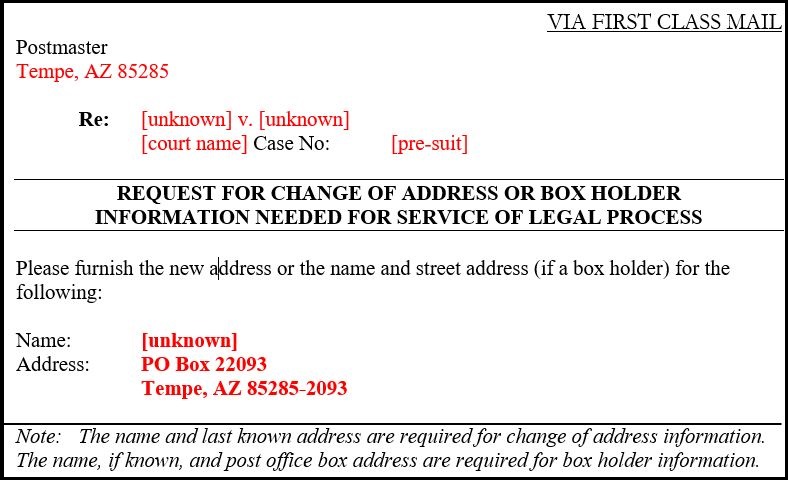
Then there are six additional items that the Post Office needs to properly determine if your request is legitimate:
- Who you are. For most people, you would just indicate “pro se party” unless you’re a lawyer.
- If you’re representing a company, you almost certainly need a lawyer. Item no. 2 is not applicable for most, but if you’re trying to sue in small claims court in Florida, you could put down Rule 7.050(a)(2) as the authority that allows the company to represent itself in court (not be unrepresented by a lawyer). Other laws might apply, but you’d need to determine that specifically. Proceed with caution if you’re a business!
- Names of people in the lawsuit. If you know this information, put it down. If you don’t know, just say so. This is not uncommon if you don’t know the name of the defendant you’re trying to sue.
- Where the case will be filed. This is usually the name of the court. So for example it might be a county court in Florida, or a circuit court, or some other court.
- The case number. If you already filed suit, put down the case number. Otherwise just say it’s “pre-suit”.
- Who you’re after. The “capacity” is simply technical jargon for whether the person you’re after with the request is a possible defendant in the current for future lawsuit, or just a witness from whom you’re trying to get information or documents.
The attached example template has the information for each category, exactly as the Post Office requires it to read. That’s it for information you need to provide. You’ll also need to include the warning in all capital letters, and bold typeface. Read and understand this warning, because it’s directed to YOU, the requester!

Next, you need to include a certification that you’re making the request for legitimate reasons. Again, remember that this request can only be used for legitimate purposes related to a lawsuit. NOTHING ELSE! Include the certification verbatim. Then you include a line where you will sign and certify, together with your own address.
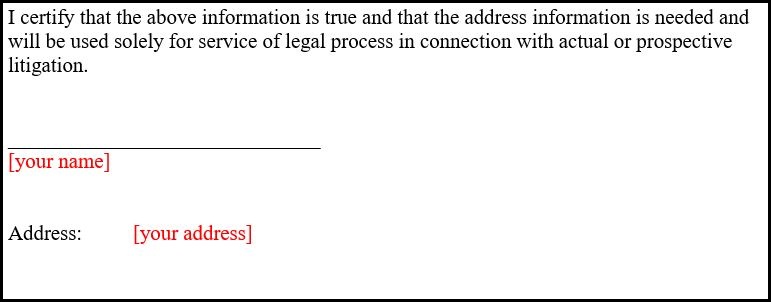
Finally, the last section is a form that you include for the Post Office to use and provide you with the information. This makes their job easier because they can just check the box, write the address or name, and then add a postmark:
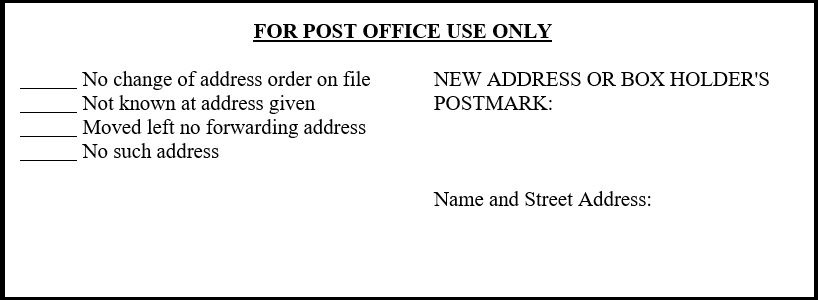
Putting all of those parts together, the letter comprises two pages. I include a template here:
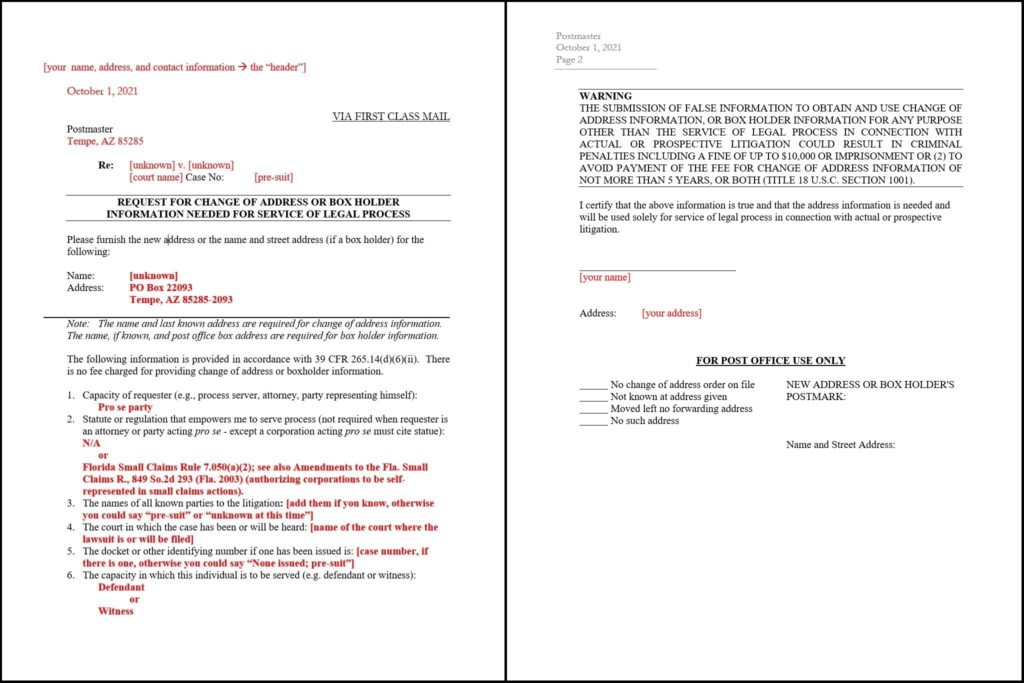
2. The Letter Envelope
OK, so how do you send mail to the mailman? That person is called the “postmaster.” The trick here is that you need to mail the letter to the postmaster who is in charge of the zip code where you’re trying to find out the information. It’s a bit counterintuitive, since there’s no street address–just the city, state, and zip code. The Postal Service will route such a letter directly to a specific zip code’s post office. So on the envelope you just write two lines:
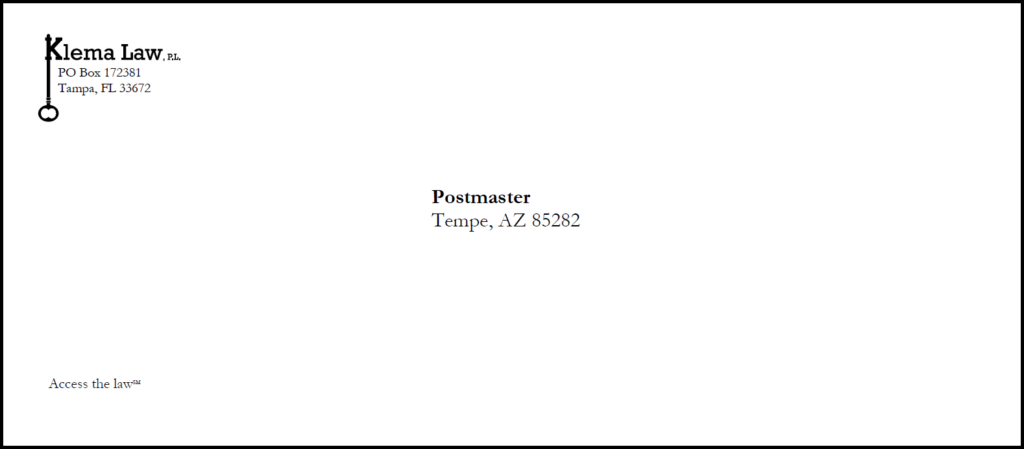
The above example address will go to the Post Office in Tempe Arizona, and the staff there will receive it and open it because it’s addressed to them. All you need to know is the zip code for the PO Box or zip code for the address.
Just like you included in the letter, all you need to put on the envelope is what post office you need to send it to. And their address is essentially just the zip code. So, your envelope should be addressed to Postmaster with the city, state, and zip code. That’s it. Be sure to include your own return address in case something goes wrong, and your request doesn’t make it to the postmaster, at least you’ll get it back in the mail.
3. The Postage-Paid, Self-Addressed Return Envelope
Finally–and this is critically important!–you need to include a postage-paid self-addressed return envelope so the post office can mail you back your letter with the information on it. They will fill out the bottom portion of your letter with the information and will usually affix an official stamp or postmark. But if you forget the return envelope, or forget to add postage to it, I guarantee you’re not getting your letter back with the information you’re requesting. Your letter is going into the trash! So, make sure you include the return envelope WITH POSTAGE! For the return address, I put down my own address again. It’s a bit odd that both the TO: and FROM: addresses are the same, but I sure don’t want the return envelope going back to the postmaster if it gets misrouted–I want it getting back to me no matter what.
This is what my return envelope looks like:
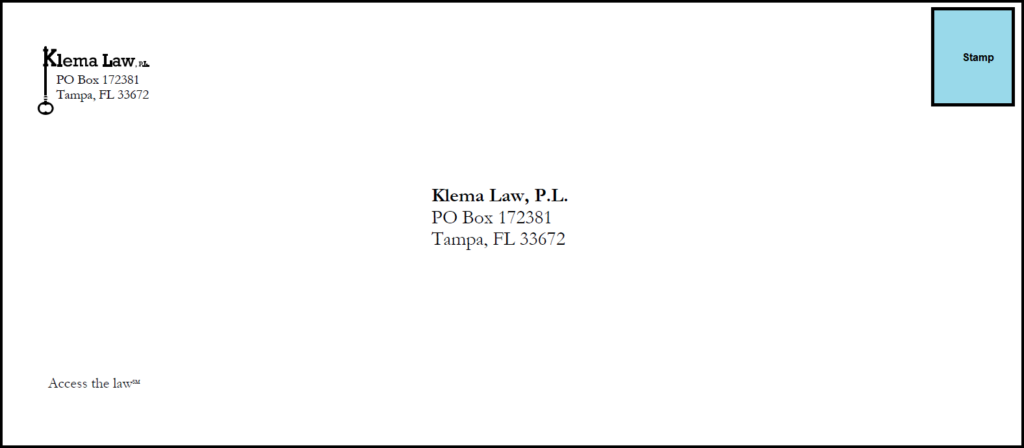
Fold the envelope into thirds so that it fits the standard size 4″x9″ envelope with your letter.
CAVEAT: Now, not all postal service employees do their jobs well (just like any other profession), and sometimes postal workers might be inexperienced in responding to these kinds of requests (they’re probably not all that common). I’ve had occasions where the letter doesn’t come back to me for months. MONTHS! Or sometimes the postal employee claims that “more information is needed” when in fact, they were just lazy or didn’t know that a name didn’t have to be provided for the boxholder information. In those cases where I didn’t get the information to which I was entitled, I just sent another letter, but this time including a little note to correct their misunderstanding, and highlighting any relevant portion of the letter they may have overlooked.
If successful, what you get back from the Post Office should look something like this:
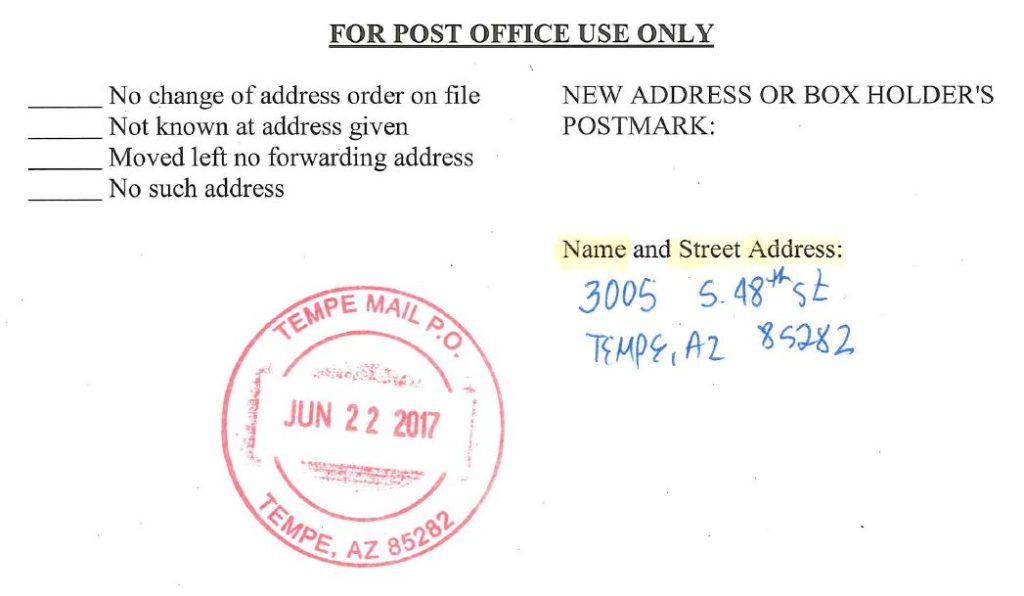
Use Cases and Examples
Some interesting use cases arise. Again, these examples contemplate either an actual or prospective lawsuit for some harm befalling you, the requester, or information you need to prove a lawsuit (you could be a defendant, actually).
Find out who is behind an eBay or other online retailer’s account. Did you buy something online and receive a letter or package, but it didn’t identify a return address? Perhaps the postage was printed from a postage meter. You can also get the owner’s information from the USPS about the person or company that owns the postage meter.
Find out who is behind junk mail. Are you receiving a ton of junk mail, or a flier is a misleading ad? Again, the mail you received should have a bulk mail permit number on it, and you can use that to find out who’s behind the mailing.
Find out who owns a PO Box. Sometimes people list a PO Box as a way to add a shield of anonymity or privacy. But if they’ve done something wrong and you want to sue them or you want them to appear and give testimony or produce documents in a lawsuit (that is, be a witness and subpoena them), then you can also use this technique. Unfortunately, this will not work for private company boxes, like United Parcel Service (UPS Store) or FedEx-Kinkos. They have no statutory Freedom of Information Act (FOIA) obligations to respond to such requests. You could, however, subpoena them to demand the information once a lawsuit has started.
This kind of request also works to identify who is behind a mass mailing, either bulk mail permit or postage meter. But that’s a bit more complicated. You probably need to know the zip code of the sender so that your request goes to the right post office. Otherwise you might try sending it to the main post office administration in Washington D.C. I’ve never tried, so can’t say.
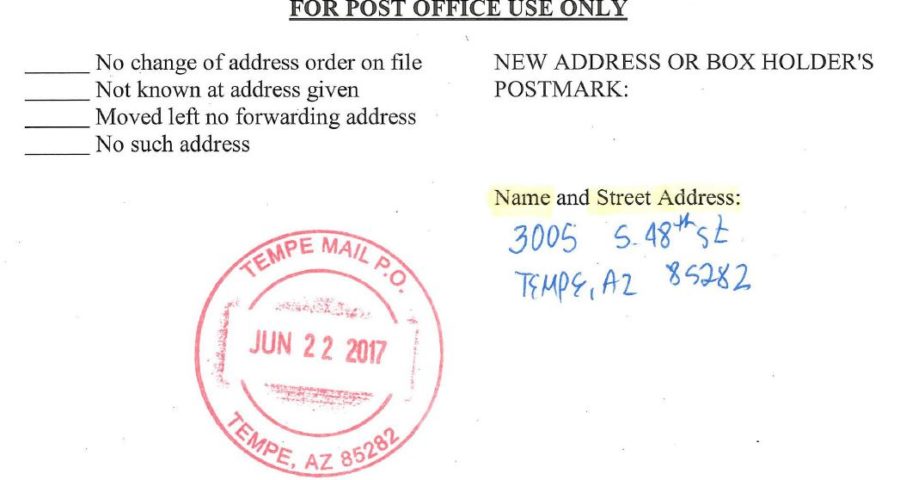
Thank you, useful information!
I have hand-delivered and mailed a letter to the postmaster with a REQUEST FOR CHANGE OF ADDRESS OR BOXHOLDER REQUEST FORM – PROCESS SERVERS on June 14, 2022, and am still waiting for production of the information. Is there a time limit governing production of the information?
No, there is no prescribed timeframe for the USPS to respond. Sometimes I’ve received them back months later. I suggest calling the specific office where the request is being made and try to speak to the person who handles those requests. That’s helped when repeated requests seem to get “lost” or the post office provides incomplete information.
Thank you for posting this, now I know what’s this weird letter that showed up in my mailbox! I live in an apartment complex and the letter is for someone that used to live in my apartment.
Any advise on what to do? I’m thinking about just putting this in the outgoing mailbox for the mail people to handle.
It should have been addressed to the postmaster, not the address of the individual. You might just return to sender if it was incorrectly addressed.
Thanks, I happened to run into the mailman and I just handed the letter to him – he said they’d take care of it.
What if the person is deceased in 1979 and he had a PO BOX which I know the address to where the PO BOX is